Fault code H1 on a Samsung washing machine
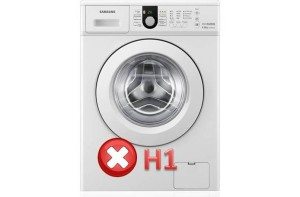 Self-diagnosis is an excellent invention introduced into washing machines. The more modern the washing machine, the more accurately it can identify the cause of its failure and find what is wrong. If error h1 appears on the display of your Samsung washing machine, then you must immediately stop using the “home assistant” and begin to figure out how to decipher this code. And we will help you in this matter.
Self-diagnosis is an excellent invention introduced into washing machines. The more modern the washing machine, the more accurately it can identify the cause of its failure and find what is wrong. If error h1 appears on the display of your Samsung washing machine, then you must immediately stop using the “home assistant” and begin to figure out how to decipher this code. And we will help you in this matter.
Possible situations that generate error H1
Let's start with the specifics of error H1. Not all models of Samsung washing machines display the H1 error when similar problems occur; in some cases, the codes NOT or NOT1 appear. Remember that these codes mean approximately the same thing - you will have to check the heating element. It would seem that what’s difficult is to unscrew the back wall of the washing machine and check the heating element for serviceability?
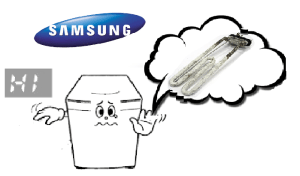 The fact is that in a Samsung car the heating element is located not at the back of the tank, but at the front. This means that you will have to remove the front wall along with the control panel, and after that access to the heating element will open. How to remove the front wall of a Samsung machine is described in one of the articles on our website. disassembling a washing machine (Indesit, Hansa, Samsung, LG, Siemens, etc.). As soon as the wall can be removed, you will need to find the cause of error H1.
The fact is that in a Samsung car the heating element is located not at the back of the tank, but at the front. This means that you will have to remove the front wall along with the control panel, and after that access to the heating element will open. How to remove the front wall of a Samsung machine is described in one of the articles on our website. disassembling a washing machine (Indesit, Hansa, Samsung, LG, Siemens, etc.). As soon as the wall can be removed, you will need to find the cause of error H1.
- Perhaps the reason is that the heating element itself or the temperature sensor burned out.
- Perhaps the heating element has shorted or one of the supply wires is not connecting.
- Either the heating element and the temperature sensor are working properly, but the overheating protection simply triggered.
Important! Each of the above reasons requires checking, and as soon as a breakdown is found, it will need to be fixed immediately, and then the machine will work without failures.
The heating element is short-circuited, burnt out or its wire does not connect
Having removed the front wall of the Samsung washing machine, we must remove the protective cover from the heating element, which is located directly under the hatch in a small niche. We pull out the cover and see in front of us two large contacts to which the wires fit. First, we must visually check how well the wires are secured and whether they are damaged. Perhaps the error is generated by this. Next, we need to take a multimeter and measure the resistance on the contacts and wires. To do this we will do the following: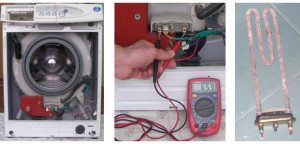
- remove the wires from the contacts of the heating element and temperature sensor;
- we measure the resistance of the heating element contacts, if the multimeter display shows a value of 28-30 Ohms, it means the heater is working; if the display shows one, it means the heating element has burned out;
- We measure the resistance on the wires, the device should show approximately the same value as when measuring the heating element, unless of course the wire is broken.
If a broken wire or burnt heating element is detected, you must either replace this wire or replace the heating element. There is nothing complicated with replacing the wire, so we will not give separate explanations, but we will talk in more detail about replacing the heating element.
- We unscrew the nut that secures the heating element to the tank; it is located directly in the center between the contacts.
- We grab the contacts of the heating element and begin to pull it towards ourselves, not forgetting to swing it from side to side.
- We take out the old heating element, and then take an old toothbrush and push it into the hole formed.Our task is to clean the scale and other debris that has accumulated there from the bottom of the tank.
- Lubricate the edges of the hole with soap and carefully insert the new heating element of the Samsung washing machine into it.
For your information! Make sure that the rubber band of the new heating element does not get lost during installation, much less break.
- We connect the wires to the new heating element and temperature sensor, install the protective cover and assemble the washing machine. Next, we run a test wash and enjoy the performance of the Samsung machine.
Thermal sensor burned out
In the vast majority of cases, the reason why error H1 “pops up” on a Samsung washing machine comes down to damaged wires, contacts and a burnt heating element. But It happens that the heating element is working properly, the wires are intact, but the error still appears. In this case, a burned out temperature sensor should be considered a possible cause. The Samsung washing machine has one type of temperature sensor - a thermistor. It is installed directly into the heating element, it is not difficult to find. We do the following: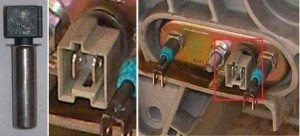
- we find a temperature sensor - this is a black plastic element with contacts that stands directly on the heating element;
- measure its resistance using a multimeter;
- remove the wiring from it;
- carefully pry it up with a flat screwdriver and pull it out;
- insert a new temperature sensor in its place and connect the wires;
- After these simple manipulations everything should work fine.
Important! A working disconnected temperature sensor should show a value close to 35 kOhm.
Overheat protection has tripped
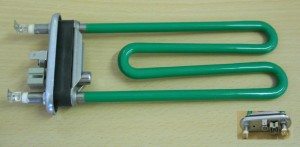 All modern heating elements are equipped with overheating protection. It works very simply. There is a spiral running inside the heating element tubes. This spiral is connected to the contacts of the heating element through a low-fusible element - this is the fuse.If the coil overheats, the fuse will melt, interrupt the circuit and the coil of the heating element will survive, and error H1 will appear on the machine display.
All modern heating elements are equipped with overheating protection. It works very simply. There is a spiral running inside the heating element tubes. This spiral is connected to the contacts of the heating element through a low-fusible element - this is the fuse.If the coil overheats, the fuse will melt, interrupt the circuit and the coil of the heating element will survive, and error H1 will appear on the machine display.
The problem is that these types of fuses are not recoverable and if they trip, the heating element will have to be replaced. But There are heating elements with reusable ceramic fuses. If it overheats, the fuse breaks off and the circuit is also interrupted. How to restore the fuse and bring the heating element back to life?
- We break off the plastic rivets of the base of the heating element body and disassemble it.
- We remove the broken ceramic element, cut it with a hacksaw blade and put it back.
- We glue the heating element body with some good heat-resistant glue.
- We check the resistance with a multimeter so that there are no surprises.
- We put the heating element in place.
Note! In places where there used to be plastic rivets on the heating element body, you can drill holes and insert small bolts there, and then tighten the body with a nut. Then it will be possible to disassemble the heating element many times in case the problem recurs.
In conclusion, we note the H1 error on a Samsung washing machine, a fairly common occurrence. Poor quality water, negative operating conditions, low-quality parts, all these are factors that contribute to the rapid failure of the heating element and its auxiliary elements. Is it possible to find and fix the problem if error H1 appears with your own hands? Of course you can, the main thing is to follow the advice of professionals and you will not be afraid of any problem caused by a system error.
Interesting:
6 reader comments
Add a comment Cancel reply
Categories
Washing machine repair


For buyers

For users

Dishwasher



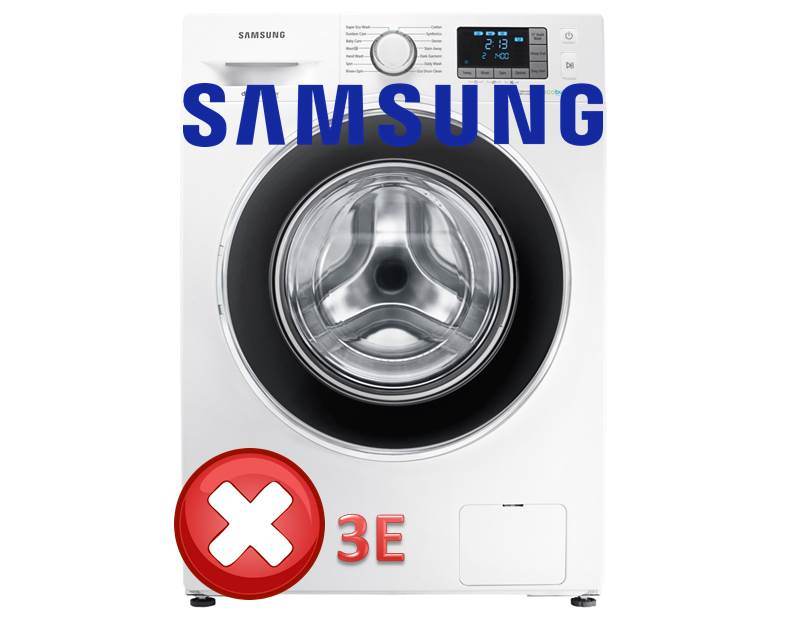
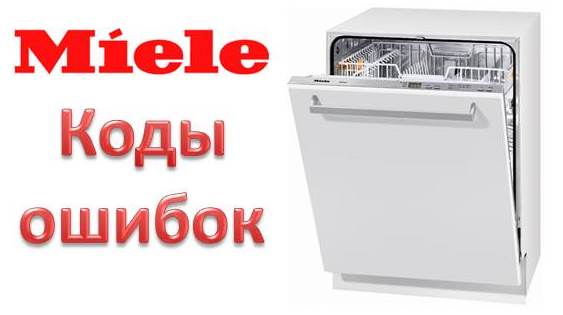

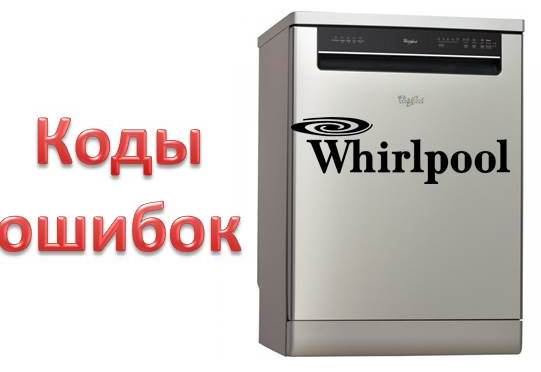










HI error
So, by the way, not all Samsung washing machines have a heating element under the front panel. For example wf-1500nhw. Don’t rush to take off the tires right away - you’ll be tortured to put them on later, just unscrew the back wall, 3 screws...
Samsung diamond 6.0 kg. Heating element behind the back cover. Take your time.
Error P1
Error code Samsung 6 kg.?
1. 5pod, or something similar. The message popped up very quickly and also disappeared,
2. There are dark flakes and scale in the drain water.